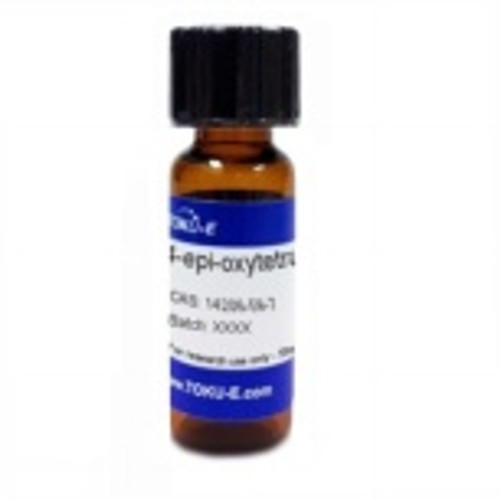Oxytetracycline was the second discovered tetracycline antibiotic.
TOKU-E offers two forms of oxytetracycline: Oxytetracycline Dihydrate (O003) and Oxytetracycline Hydrochloride (O004). Oxytetracycline dihydrate is sparingly soluble in aqueous solution at 0.6 mg/mL. Oxytetracycline HCl is slightly soluble in aqueous solution at 6.9 mg/mL.
| Mechanism of Action | The mechanism of oxytetracycline involves diffusing through a cell and binding to the 30s ribosomal subunit preventing peptide elongation and ultimately inhibiting protein synthesis. Resistance to oxytetracycline can be a result of inactivation by cell enzymes or pumping the antibiotic out of the cell upon entering. |
| Spectrum | Oxytetracycline is a broad spectrum antibiotic which targets gram positive and gram negative species as well as a few Mycoplasma species. |
| Microbiology Applications | Oxytetracycline is commonly used in clinical in vitromicrobiological antimicrobial susceptibility tests (panels, discs, and MIC strips) against gram positive, gram negative, and Mycoplasma microbial isolates. Medical microbiologists use AST results to recommend antibiotic treatment options for infected patients. Representative MIC values include:
Media SupplementOxytetracycline is used as a selective agent in OGYE, a selective media for yeasts and molds. |
| Plant Biology Applications | Oxytetracycline has been used to prevent fire blight in apple and pears in the Pacific Northwest of the USA. In a study by Hubbard et al. (2011), oxytetracycline was shown to be a better alternative to streptomycin to inhibit fire blight disease. |
| Molecular Formula | C22H24N2O9•2H2O |
| Solubility | Water: 0.6 mg/mL Acids (pH 1.2): 31 mg/mL Bases (pH 9.0): 38 mg/mL |
| References | Chopra, Ian, and Marilyn Roberts. "Tetracycline Antibiotics: Mode of Action, Applications, Molecular Biology, and Epidemiology of Bacterial Resistance." Microbiology and Molecular Biology Reviews (2001): 232-60. Http://www.ncbi.nlm.nih.gov. Web. 21 Aug. 2012. Hubbard A.R., 2011, Evaluation of Kasugamycin-use strategies Designed to Delay Development of Resistance in Erwinia amylovora. Master thesis of Botany and Plant Pathology, Oregon state University. |
| MIC | Bacillus cereus (ATCC 10702)| 1 - ?| 1302| Bacillus pumilus (ATCC 14884)| 2 - ?| 1302| Bacillus pumilus (ATCC 14884)| 2 - ?| 1183| Bacillus subtilis| 16 - ?| 1183| Bacillus subtilis| 16 - ?| 1183| Brochothrix thermosphacta| 124 - ?| 861| Burkholderia mallei (Pakistan)| ? - ?| 655| Clavibacter michiganensis subsp. michiganensis (185. 2. 1)| 4 - ?| 727| Clavibacter michiganensis subsp. michiganensis (C 8.2)| 4 - ?| 727| Clavibacter michiganensis subsp. michiganensis (IVIA-613)| 4 - ?| 727| Clavibacter michiganensis subsp. michiganensis (IVIA-873)| 4 - ?| 727| Diplococcus pneumoniae| 0.04 - 0.4| 1413| Enterococcus faecalis| 0.78 - >100| 1030| Enterococcus faecalis (broiler isolate)| 0.78 - >100| 1030| Enterococcus faecalis (cattle isolate)| 1.56 - >100| 1030| Enterococcus faecalis (pig isolate)| 0.78 - >100| 1030| Enterococcus faecium| 0.39 - >100| 1030| Enterococcus faecium (broiler isolate)| 0.39 - >100| 1030| Enterococcus faecium (cattle isolate)| 0.39 - >100| 1030| Enterococcus faecium (pig isolate)| 0.39 - >100| 1030| Enterococcus hirae| 0.39 - >100| 1030| Enterococcus sp. (Uraguay)| ≤0.25 - 2| 1391| Escherichia coli (ATCC 25922)| 0.25 - 2| 1127| Escherichia coli (K12 LE140)| 1.95 - ?| 1265| Escherichia coli (O157:H7)| 70 - ?| 861| Flavobacterium columnare| 15.63 - ?| 1347| Fusobacterium necrophorum| 0.03 - 4.1| 1444| Haemophilus influenzae| 1.6 - 6.3| 1413| Haemophilus parasuis (Spain)| 0.25 - 16| 768| Haemophilus parasuis (UK)| 0.25 - 16| 768| Klebsiella pneumonia (ATCC 10031)| 16 - ?| 1183| Listeria monocytogenes| 58 - ?| 861| Micrococcus kristinae| 1 - ?| 1302| Micrococcus kristinae| 4 - ?| 1183| Micrococcus luteus| 4 - ?| 1183| Mycoplasma bovis (Britain)| 1 - 128| 598| Mycoplasma bovis (Italy)| 0.12 - 4| 598| Mycoplasma bovis (Netherlands)| 8 - >64| 598| Mycoplasma gallisepticum| 0.05 - 200| 599| Mycoplasma gallisepticum (1975-1989)| 0.12 - 1| 606| Mycoplasma gallisepticum (1990-2000)| 0.05 - 200| 606| Mycoplasma gallisepticum (41-91)| 0.125 - ?| 595| Mycoplasma gallisepticum (ATCC 15302)| 0.125 - ?| 595| Mycoplasma hyopneumoniae| 0.25 - 4| 760| Mycoplasma hyopneumoniae| 0.12 - 2| 761| Mycoplasma hyopneumoniae (ATCC 25634)| 0.12 - ?| 594| Mycoplasma hyopneumoniae (ATCC 25634)| 0.12 - ?| 594| Mycoplasma hyopneumoniae (ATCC 25634)| 1 - ?| 594| Mycoplasma hyopneumoniae (field isolate + final)| 0.12 - >2| 761| Mycoplasma hyopneumoniae (field isolate + initial)| 0.03 - 2| 761| Mycoplasma hyopneumoniae (Final reading + Belgian)| 0.12 - >2| 594| Mycoplasma hyopneumoniae (Initial reading + Belgian)| 0.03 - 2| 594| Mycoplasma hyopneumoniae (J-strain + final)| 1 - ?| 761| Mycoplasma hyopneumoniae (J-strain + initial)| 0.12 - ?| 761| Mycoplasma hyosynoviae| 0.5 - >4| 1513| Mycoplasma iowae (1990-2000)| 0.025 - 100| 606| Mycoplasma iowae (90168)| 0.25 - ?| 595| Mycoplasma iowae (I 695)| 0.25 - ?| 595| Mycoplasma meleagridis (1975-1989)| 0.3 - 5| 606| Mycoplasma meleagridis (1990-2000)| 0.05 - 25| 606| Mycoplasma synoviae| 0.025 - 100| 599| Mycoplasma synoviae (1975-1989)| 0.06 - 0.08| 606| Mycoplasma synoviae (1990-2000)| 0.025 - 100| 606| Mycoplasma synoviae (WVU 1853)| 0.125 - ?| 595| Nocardia asteroides| 25 - 100| 1404| Paenibacillus larvae| 0.016 - 0.031| 1353| Pasteurella haemolytica| >64 - ?| 1022| Proteus vulgaris| 64 - ?| 1183| Proteus vulgaris (ATCC 6830)| 16 - ?| 1302| Proteus vulgaris (CSIR 0030)| 32 - ?| 1183| Pseudomonas aeruginosa (ATCC 19582)| 8 - ?| 1302| Pseudomonas flourescens| 40 - ?| 861| Salmonella enterica| 112 - ?| 861| Salmonella spp.| 2 - ?| 1302| Shigella flexneri| 1 - ?| 1302| Staphylococcus (coagulase-negative + Uruguay)| ≤0.25 - >64| 1391| Staphylococcus aureus| 76 - ?| 861| Staphylococcus aureus (ATCC 6538)| 4 - ?| 1183| Staphylococcus aureus (ATCC 6538)| 4 - ?| 1302| Staphylococcus aureus (OKOH1)| 1 - ?| 1302| Staphylococcus aureus (Uruguay)| ≤0.25 - >64| 1391| Staphylococcus epidermidis| 4 - ?| 1183| Streptococcus agalactiae (Uruguay)| ≤0.25 - 2| 1391| Streptococcus dysgalactiae (Uruguay)| >4 - >64| 1391| Streptococcus faecalis (ATCC 29212)| 8 - ?| 1183| Streptococcus iniae| 10 - ?| 1341| Streptococcus pneumonia (ATCC 6303 + quinolone-susceptible)| 0.5 - ?| 437| Streptococcus pneumonia (ATCC 7257 + quinolone-resistant)| 0.125 - ?| 437| Streptococcus uberis (Uruguay)| ≤0.25 - 64| 1391| Treponema hyodysenteriae| 0.78 - 25| 1427| Vibrio cholerae| 56 - ?| 861| Vibrio harveyi| 0.78 - ?| 1428| |








